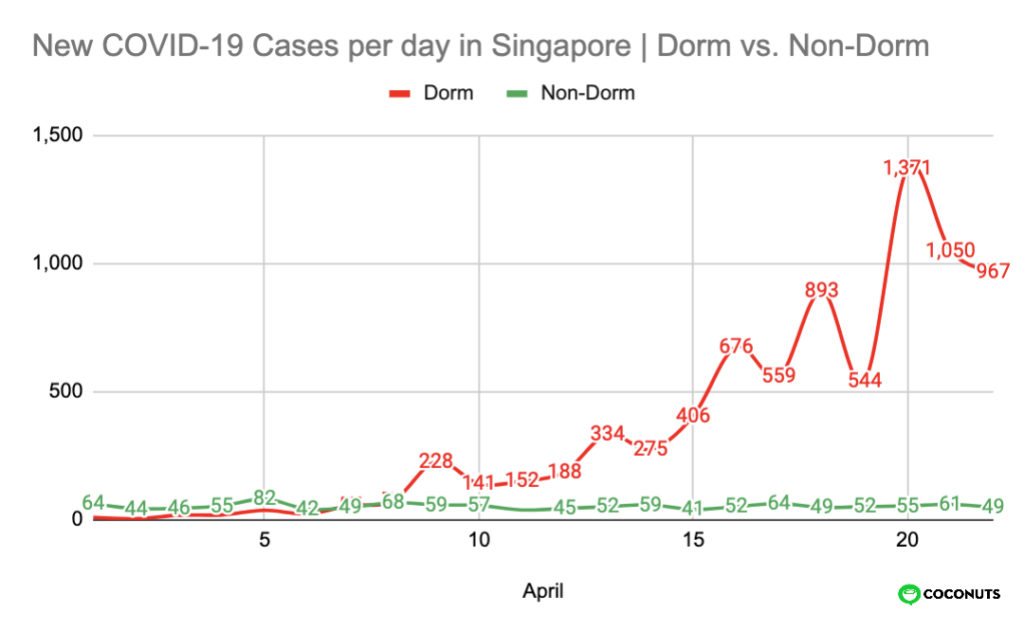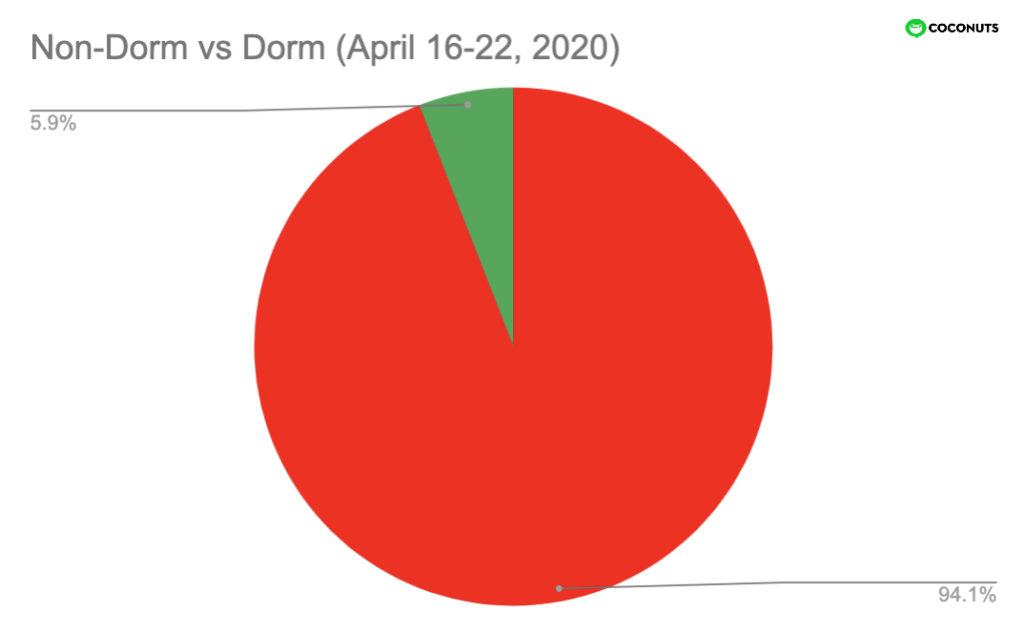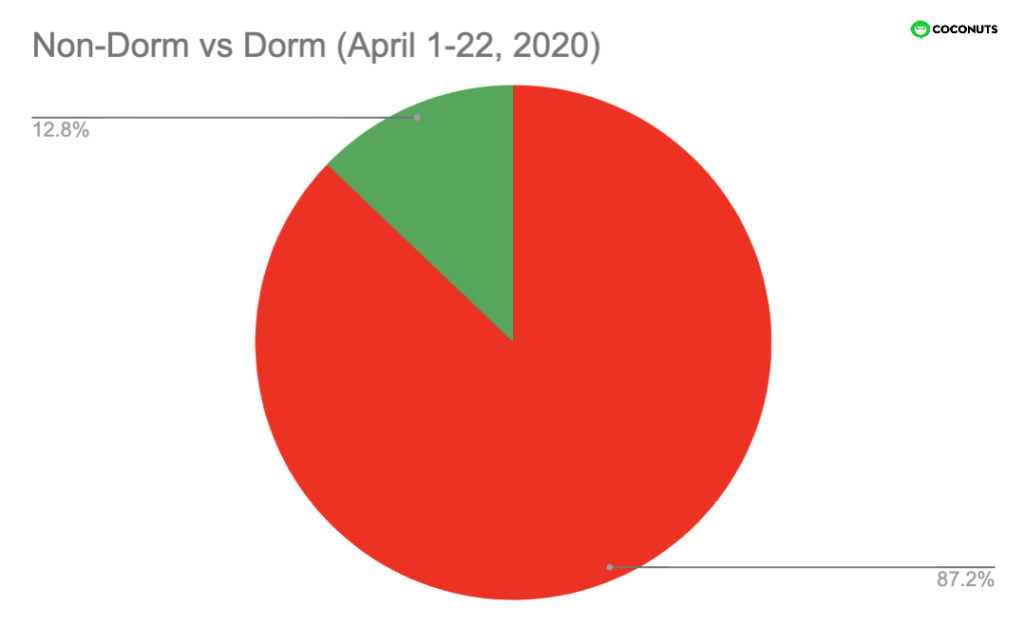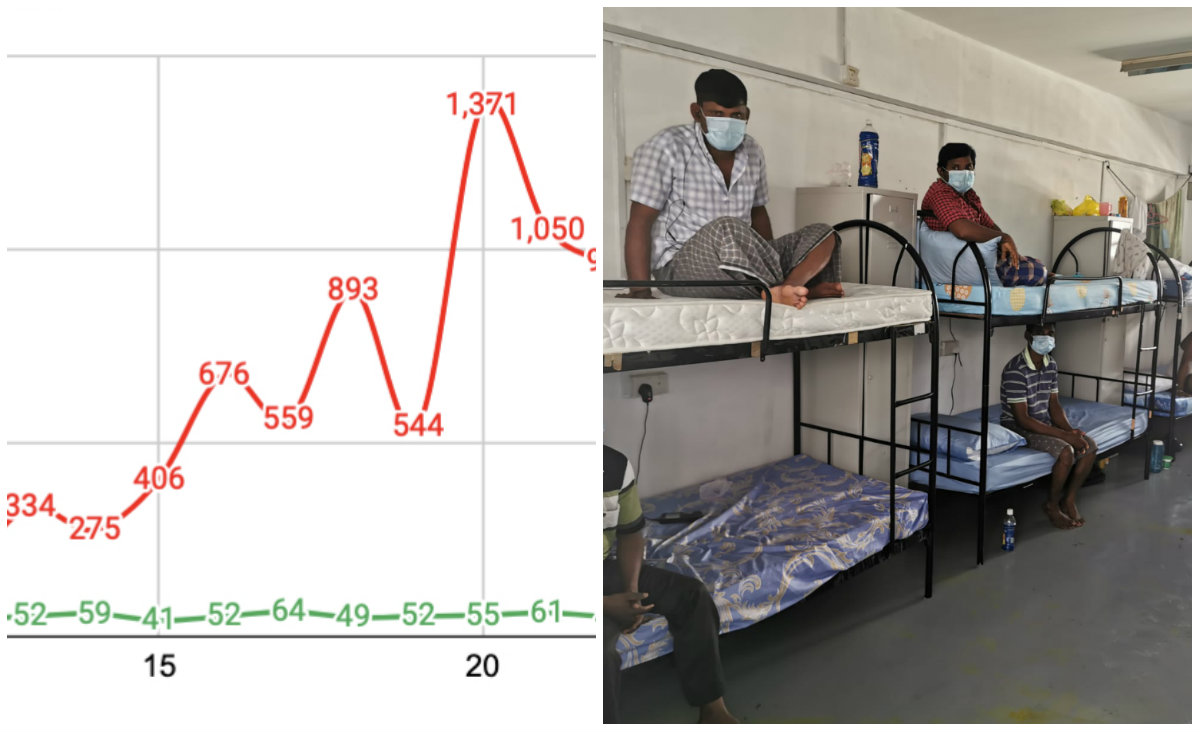As Singapore surpasses 10,000 known COVID-19 cases, 94% of new cases in the last seven days have been found in migrant worker dormitories, where dozens share rooms in cramped quarters.
Since the start of April, 87% of Singapore’s new COVID-19 cases were detected in migrant worker dormitories, which now account for 80% of overall cases.
Meanwhile, the rate of infections outside the dorms has generally been flat since the beginning of the month. Migrant workers not living in dorms account for most of the other cases, along with people entering the city infected and some limited cases of local transmission not involving workers.
The government has also made the controversial decision to keep separate tallies: one for migrant workers, and one for Singaporean citizens and permanent residents. It has been accused of “othering” the migrant population, especially by euphemistically referring to citizens and residents as “the community.”

As of Thursday morning, 8,094 cases, or nearly 80% of all confirmed infections since January, were found in the dorms, where living conditions make keeping distant difficult or impossible.
“If one is infected, it would easily spread among others,” a resident of the S11 Dormitory @ Punggol told Reuters. Habibur Rahman, 29, a worker from Bangladesh, said he shares a room with 11 others.
“Currently we are confined to our room. Everyone is scared. We are just praying to Allah… praying five times a day.”
The rise in cases has been attributed to more frequent COVID-19 testings of dorm residents, including those who do not show symptoms.
At least 30 licensed dormitories have been hit by the coronavirus, with other major dormitory clusters including the Sungei Tengah Lodge with 684 cases and Tuas View Dormitory with 603 cases so far.
Twenty-one dorms have been put on lockdown and none of the migrant workers has been allowed to go to work, Manpower Minister Josephine Teo announced Tuesday.
The virus’s explosive spread in migrant worker dormitories became widely noted April 5, when the government declared the S11 Dormitory @ Punggol and Westlite Toh Guan Dormitory as isolation areas following spikes in cases, effectively putting around 20,000 people on lockdown.
They were the hardest-hit dormitories at the time with 63 and 28 cases, respectively. The number of new known infections at Westlite Toh Guan appears to have slowed since then, with 161 cases as of this morning. It now accounts for the eighth most infections.
The disease’s spread helped expose the filthy and cramped living conditions of the S11 Dormitory @ Punggol dormitory, which has become the epicenter for the outbreak in Singapore’s with more than 2,000 infected. But the Ministry of Manpower said it has stepped up cleaning and relocated some healthy workers to other places such as army camps and floating facilities, freeing up space for safe distancing.

The situation is in stark contrast to over two months ago, when Singapore reported its first infection involving a migrant worker living in a dorm. The city-state only had around 40 cases then.
The 39-year-old construction worker from Bangladesh tested positive Feb. 9 and was in the ICU two months. He was reportedly moved just last week to a general ward at Changi General Hospital.
The man was also linked to Singapore’s first known construction site cluster of just five cases at 10 Seletar Aerospace Heights. He lived at The Leo dormitory in Kaki Bukit and had visited the Mustafa Centre, a popular 24-hour department store, prior to being hospitalized.
No known infections were reported in dorms for most of March, when Singapore saw a rise in imported infections amid a surge of returning travelers. This peaked around March 23, according to government data.
Fast forward to April, when both The Leo dormitory and the Mustafa Centre were identified as clusters. The former turned out to be one of the smallest dormitory clusters with 27 cases as of this morning while more than 100 occurred at the Little India department store, which is frequented by locals, tourists, and migrant workers alike.
Dormitory clusters continue to grow. Currently, the S11 Dormitory @ Punggol makes up a quarter of total infections in all dorms since it was identified as a cluster on March 30.

The continuous growth in cases has been attributed to more COVID-19 testing, Health Minister Gan Kim Yong told reporters Wednesday. Of the roughly 3,000 tests performed daily, he said that between 1,500 and 2,500 were administered to workers.
Infections outside the dorms may have slowed since the start of April, but that doesn’t mean the general population is free of the virus.
In announcing the extension of Singapore’s partial lockdown on Wednesday, Prime Minister Lee Hsien Loong said there could be a “hidden reservoir” of infections. Just days earlier, the Health Ministry said it had been detecting coronavirus-positive patients during its monitoring.
“We have an ongoing surveillance programme, where a small sample of patients at our primary care facilities are tested for COVID-19 infections. We have picked up some cases through these tests, which is an indication of undetected cases in the community,” it said in a daily COVID-19 update.
The now-extended “circuit breaker” measures are meant to prevent outbreaks of new clusters outside the dorms by limiting human contact, but two weeks since the stricter measures kicked in on April 7, reports have shown large groups of people still out and about.
Related:
First Bangladesh national infected by coronavirus in Singapore
COVID-19: Singapore isolates construction workers to battle surging infections
Filthy, cramped dorms come to light as virus afflicts Singapore’s migrant workers





Reader Interactions